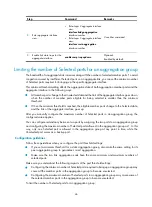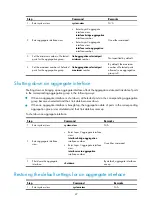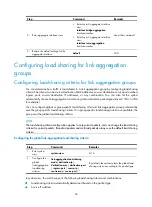
57
Aggregation Mode: S -- Static, D -- Dynamic
Loadsharing Type: Shar -- Loadsharing, NonS -- Non-Loadsharing
Actor System ID: 0x8000, 000f-e2ff-0001
AGG AGG Partner ID Select Unselect Share
Interface Mode Ports Ports Type
-------------------------------------------------------------------------------
RAGG1 S none 3 0 Shar
The output shows that link aggregation group 1 is a load-sharing-capable Layer 3 static
aggregation group that contains three Selected ports.
# Display the global link-aggregation load-sharing criteria on Device A.
[DeviceA] display link-aggregation load-sharing mode
Link-Aggregation Load-Sharing Mode:
destination-ip address, source-ip address
The output shows that the global link-aggregation load-sharing criteria are the source and
destination IP addresses of packets.
Layer 3 dynamic aggregation configuration example
Network requirements
As shown in
•
Device A and Device B are connected by their Layer 3 Ethernet interfaces Ethernet 1/0/1 through
Ethernet 1/0/3.
•
Configure a Layer 3 dynamic aggregation group on both Device A and Device B and configure IP
addresses and subnet masks for the corresponding Layer 3 aggregate interfaces.
•
Enable traffic to be load-shared across aggregation group member ports based on source and
destination IP addresses.
Figure 17
Network diagram
Configuration procedure
1.
Configure Device A:
# Create Layer 3 aggregate interface Route-Aggregation 1, configure the link aggregation mode
as dynamic, and configure an IP address and subnet mask for the aggregate interface.
<DeviceA> system-view
[DeviceA] interface route-aggregation 1
[DeviceA-Route-Aggregation1] link-aggregation mode dynamic
[DeviceA-Route-Aggregation1] ip address 192.168.1.1 24
[DeviceA-Route-Aggregation1] quit
# Assign Layer 3 Ethernet interfaces Ethernet 1/0/1 through Ethernet 1/0/3 to aggregation
group 1.
[DeviceA] interface ethernet 1/0/1
















































